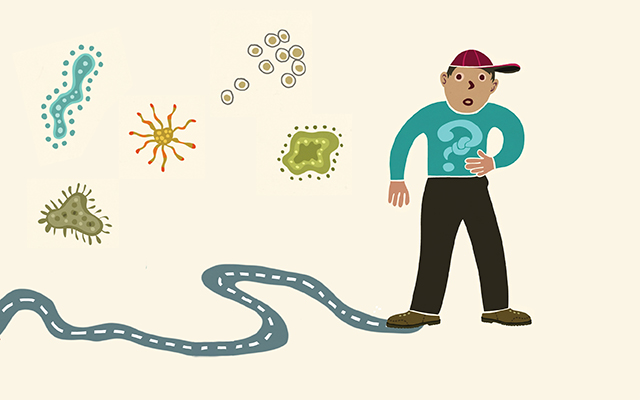John Minot was out of options. At 30 years old, he had suffered from recurrent diarrhea, urgency, and intermittent rectal bleeding since his sophomore year of college. A 2008 colonoscopy revealed he had ulcerative colitis.
During the intervening years, Minot treated his symptoms with nearly every conventional medicine option. Steroids helped at first but required progressively stronger doses with diminishing effects. Other, more potent medications either didn’t work or came with debilitating side effects, including flu-like symptoms and malaise.
So Minot, feeling disappointed in the care he had received, halted all his meds. And his suffering persisted.
Not usually one to pursue alternative treatments, Minot felt he had no other choice. So, in 2015, he went to see Robert Rountree, MD, an integrative-medicine practitioner based in Boulder, Colo.
Luckily, Rountree — who shared Minot’s case study in a presentation at the 2023 Integrative Healthcare Symposium — had a tool many conventional practitioners didn’t: an interest in the root cause of Minot’s chronic gastrointestinal (GI) distress. He suspected it went beyond ulcerative colitis.
To create the best treatment protocol for Minot (a pseudonym used to protect his privacy), Rountree used a diagnostic framework with the acronym DIGIN. It stands for digestion, intestinal permeability, gut microbiota, inflammation/immunity, and the nervous system.
Functional-medicine providers like Rountree believe the cause of almost every GI disturbance can be traced to one or more of these areas. And once the origin of someone’s symptoms has been identified — even symptoms as complicated as Minot’s — sustained relief becomes possible, even if it doesn’t happen overnight.
GI Trouble
According to the most recent information from the National Institutes of Health, 60 to 70 million Americans have some type of digestive disorder — around one in five of us. Among the most common are irritable bowel syndrome (IBS), chronic constipation, diarrhea, gastroesophageal reflux disease (GERD), gallbladder problems, ulcers, diverticulitis, hemorrhoids, and inflammatory bowel diseases (IBD) such as Crohn’s and ulcerative colitis.
This doesn’t even include other chronic conditions that often have digestive components, such as autoimmune diseases, migraine, and skin problems.
60 to 70 million Americans have some type of digestive disorder — around one in five of us.
One look at this diverse list and it’s clear why cookie-cutter approaches to gut health often fall short. Digestion involves and affects many different body parts and processes. “Two people with the same diagnosis may need completely different therapies,” notes integrative nutritionist Liz Lipski, PhD, CNS, author of Digestive Wellness. “And two people with completely dissimilar diagnoses may benefit from the same therapy.”
For instance, conditions as varied as IBS, migraine, and fibromyalgia may share an underlying cause of food intolerances. And three people with IBS may have different triggers, such as small intestinal bacterial overgrowth (SIBO), food sensitivities, or stress.
Lipski created the DIGIN protocol with other functional-medicine practitioners to help them address the unique causes of GI issues, not just their symptoms. This is how it works.
Digestion
Inadequate chewing, rushed eating, gastric-acid insufficiency, enzyme insufficiency, lack of fiber, and poor hydration can all lead to poor digestive function (discover why it’s vital to maintain your daily hydration needs at, “The Importance of Hydration For Daily Detoxing“). This is how many GI issues start.
“Most of us eat quickly, without paying much attention,” Lipski says. “Chewing is the beginning of the digestive process. The function of the teeth is to masticate the food so the rest of the digestive system doesn’t have to work so hard to digest it.”
Saliva also contains enzymes that begin breaking food down. Rushing through this phase can create problems farther down the digestive tract.
Once food reaches the stomach, hydrochloric acid (HCl) and digestive enzymes begin their work, breaking up large protein molecules. This allows them to be more easily dismantled by digestive enzymes in the small intestine. HCl helps protect us against parasites, viruses, and bacteria while also facilitating the absorption of minerals, such as iron, calcium, copper, and magnesium.
Low HCl can hamper all these digestive functions and lead to nutrient malabsorption. Signs of low stomach acid include frequent bouts of food poisoning, belching and burping, or a diagnosis of SIBO.
Causes of low HCl can include chronic stomach inflammation, bacterial infection, or acid-reducing medications such as proton pump inhibitors. If you suspect you’re low, try digestive bitters; they can be a safe tool to help stimulate the body’s production of HCl.
Acid-blocking drugs are among the most commonly used class of drugs in America, notes functional-medicine doctor Mark Hyman, MD, on his podcast, The Doctor’s Farmacy — and this has drawbacks for digestion.
“They change the pH in the stomach, so while you may not have heartburn, you [could] end up getting IBS.” (For more on antacids, visit “The Trouble With Antacids.”)
Digestive enzymes are another critical factor in digestion. The most important enzymes are produced by the pancreas to break down fats, carbs, and proteins. The small intestine generates enzymes to process sucrose and lactose.
Many people with GI issues suffer enzyme deficiencies, leaving them unable to digest certain foods. This often shows up as an intolerance of lactose, gluten, fructose, or sucrose.
Many people with GI issues suffer enzyme deficiencies, leaving them unable to digest certain foods. This often shows up as an intolerance of lactose, gluten, fructose, or sucrose.
When Minot first came to Rountree, he was already limiting processed foods and sweets. Rountree urged him to make a few more changes, including cutting out gluten and dairy — two foods with the potential to provoke an inflammatory response from the immune system when the body can’t assimilate their proteins.
“It’s surprising how many people don’t have enough enzymes to fully break down their food,” Lipski says. “That’s kind of an easy fix, because people can take digestive enzymes supplementally.”
Multiple studies worldwide have reported improvements in IBS symptoms with multienzyme preparations. If you suspect a digestive-enzyme deficiency, ask your physician to do a screening. (For more on digestive enzymes, see “Should I Take Digestive Enzymes?“)
Insufficient dietary fiber is another common digestive hurdle. The soluble fiber found in fruit, beans, and flaxseed helps keep our intestinal pH in balance, and the insoluble fiber found in bran, vegetables, and whole grains helps keep us regular. Fiber is also crucial for feeding beneficial microbes in the gut.
Most of us don’t get nearly enough fiber. According to the Mayo Clinic, women should aim to consume 21 or 25 grams of fiber each day; men should shoot for 30 or 38. (The lower numbers are for older adults; we need less fiber as we age.) Most Americans average about 15 grams per day. (For more on fiber, visit ELmag.com/fiber.)
Intestinal Permeability
A condition called leaky gut often contributes to chronic GI issues, so the next stage in a DIGIN approach is ensuring the integrity of the gut lining.
The gut is lined with a thin layer of cells tasked with letting nutrients pass into the bloodstream while containing larger particles of food waste. The intestinal lining — just one-cell thick — is all that’s keeping the immune system from creating havoc in and around the gut.
Meanwhile, modern life subjects our digestive tracts to an onslaught of offenses, including chronic stress, antibiotics, nonsteroidal anti-inflammatory drugs (NSAIDs), processed foods, alcohol, and environmental toxins. This can lead to gaps between the cells of the intestinal lining.
Modern life subjects our digestive tracts to an onslaught of offenses, including chronic stress, antibiotics, nonsteroidal anti-inflammatory drugs (NSAIDs), processed foods, alcohol, and environmental toxins.
“Then bigger molecules are able to cross through,” Lipski explains. “Those may be food molecules that can set off food sensitivities, or they could be bacteria, fungi, parasites, pesticides, or herbicides. The bloodstream doesn’t have a good way of dealing with any of that other than [by] creating an immune reaction.”
This reaction can spark irritation and inflammation well beyond the digestive system, leading to conditions as diverse as migraine, skin reactions, and joint pain. Within the digestive tract, symptoms of leaky gut might include bloating, gas, or cramps.
Fortunately, the intestinal lining renews itself every few days. Unfortunately, Lipski says, the body defers that repair and maintenance when we’re under chronic stress.
Identifying and treating leaky gut can often relieve chronic gut discomfort, and it’s not complicated. Most functional practitioners recommend the following 5R protocol:
- Remove sources of gut-lining irritation, such as processed foods, parasites, and chemicals.
- Replace missing enzymes, HCl, and bile salts with supplements and lifestyle changes.
- Reinoculate with healthy microflora by consuming prebiotic and probiotic foods and supplements.
- Repair the gut lining with antidotes like bone broth, collagen powder, and L-glutamine.
- Rebalance by reducing stress and calming the nervous system with meditation, social connections, joyful pursuits, and exercise.
To help Minot repair his leaky gut, Rountree recommended he supplement with L-glutamine, a primary fuel source for cells in the intestinal lining; with zinc, a mineral shown to help restore intestinal integrity; and with curcumin, an anti-inflammatory compound in turmeric.
(For more on healing a leaky gut, see “How to Heal a Leaky Gut.”)
Gut Microbiome
Research on the gut microbiome — the trillions of microbes that occupy our digestive tracts — has exploded in recent years. These studies have yielded several key insights that can help people get to the bottom of their digestive woes.
We now understand that our microbes play an enormous role in our physical and mental health. We also know that greater microbial diversity corresponds to greater health resilience.
The same things that trigger leaky gut — processed foods, lack of fiber, chronic stress, antibiotics, poor sleep, and environmental chemicals — are also doing a number on the diversity of the average American’s microbiome. This, in turn, is depleting our health.
Take Minot. His consultation with Rountree suggested an imbalanced microbiome was the likeliest culprit for his ongoing gut troubles. Among his risk factors: He had been born by Cesarean section, depriving him of the healthy dose of microbes from a vaginal birth. His parents favored antimicrobial cleaning products, further reducing his exposure to routine microflora as a kid. He suffered recurring respiratory infections in high school and was routinely treated with antibiotics, which kill the good bugs along with the bad. And he had gum disease, which is associated with a disrupted oral microbiome.
Stool tests soon revealed Minot was indeed low in several beneficial bacterial species, including Faecalibacterium prausnitzii and Akkermansia muciniphila. These tend to be depleted in people with IBD, potentially contributing to both leaky gut and inflammatory immune responses.
There’s no single model for the perfect community of gut bacteria. Some people can have a presence or absence of certain bugs and feel perfectly well.
There’s no single model for the perfect community of gut bacteria. Some people can have a presence or absence of certain bugs and feel perfectly well. But Minot’s symptoms indicated that his microbial balance was out of whack. And when it comes to the microbiome, function is what counts.
“When it’s functioning well, digestion works so well that we don’t even notice it,” Lipski says.
But when microbial balance is disrupted, issues like gas, bloating, eczema, psoriasis, arthritis, and headaches can rear their heads. “Imbalances in the microbiome have been associated with conditions [including] glaucoma, kidney disease, diabetes, cancers, and fatty liver,” she adds.
The microbiome is exquisitely sensitive to inputs, responding to food, medication, sleep, exercise, stress — often within 24 to 48 hours. While this means it’s easily disrupted, it also means we have multiple opportunities to make choices that support our microbiome each day. These may include eating more fiber, consuming more fermented foods, working with a provider to select helpful herbs or supplements, and incorporating healthy movement.
In Minot’s case, Rountree recommended a multistrain probiotic, along with an herbal antimicrobial mouthwash to eliminate the harmful bacteria in his mouth.
Because diets high in fat and sugar have been shown to promote dysbiosis in people with IBD, he also recommended that Minot cut out refined carbohydrates and minimize red meat.
On top of these changes, Minot started making his own kombucha and getting his hands dirty in his garden. Both efforts brought him in contact with more healthy bacteria.
Within four months of his initial visit to Rountree, he reported that he was feeling “kick ass” and experiencing far fewer symptoms — just from supporting his microbiome.
Immunity & Inflammation
Though immunity and inflammation might seem irrelevant to gut healing, that’s not the case: Roughly 70 percent of the immune system is found in the gut. This is partly why gut dysregulation can lead to system-wide issues with immune activation and inflammation, including autoimmunity, psoriasis, and allergies.
Several immune-system biomarkers can signal inflammation in the gut. Patients with IBD, for instance, often show elevated levels of immunoglobulin A, which is associated with a simmering immune response. Other markers, such as ferritin, albumin, and calprotectin, can point to various issues with inflammation and autoimmunity.
It’s possible to have problematic inflammation at pretty much every point along the digestive tract, notes Lipski, even for those without IBD.
Roughly 70 percent of the immune system is found in the gut.
And what happens in the GI tract rarely stays there. Inflammation of the esophagus may lead to painful heartburn and an elevated risk of esophageal cancer.
Stomach inflammation can yield ulcers, while inflammation in the small intestine can show up as leaky gut, gas, bloating, diarrhea, constipation, or autoimmunity. In the colon, inflammation can be related to IBD and diverticulitis.
What’s behind all this inflammation in our guts?
Mostly food. Fried food, sodas, and other ultraprocessed fare will do it, as well as any foods that we’re allergic or sensitive to. “Eating is the most potentially inflammatory thing we do in our lives — because we eat a few pounds of food every day, and if it’s not helpful food that our bodies can use, we end up inflamed,” Lipski says.
Simmering infections, chronic stress, and environmental toxins can also trigger GI inflammation.
Temporary elimination diets, probiotics and prebiotics, quality sleep and relaxation, and regular exercise may all help reduce inflammation. Certain supplements may also be helpful, including L-glutamine, omega-3 fatty acids, N-acetylglucosamine, and anti-inflammatory herbs and nutraceuticals.
Minot had high levels of calprotectin, an inflammation marker strongly associated with IBD. As he supplemented his vitamin deficiencies, repaired his gut lining, and rebalanced his microbiome, he managed to dramatically reduce his gut inflammation and his calprotectin levels, Rountree reported.
Nervous System
The brain and the gut are connected by a long, branching nerve called the vagus — a key part of what’s known as the gut–brain axis. “The vagus nerve is continuously sending information back and forth between the brain and the gut,” Lipski explains.
The parasympathetic nervous system helps us rest and digest, while the sympathetic nervous system activates the fight-or-flight response — which effectively shuts digestion down. To function properly, Lipski says, the digestive system needs our fight-or-flight system to turn off and the relaxation response to take over.
The gut–brain connection helps explain why dysbiosis and GI inflammation often correspond to cognitive issues, she notes. “When the digestive system is off, it sends messages to the brain saying, ‘Hey, I’m not OK.’”
More than 90 percent of the mood-regulating neurotransmitter serotonin is made in the gut. Mood disorders, ADHD, brain fog, and anxiety may all have gut dysregulation as a root cause.
“I’ve worked with patients who suffered from depression or anxiety, and when we do an elimination diet, all of a sudden they feel completely different emotionally,” Lipski adds. (Find the functional-medicine elimination diet here.)
Here’s the good news: Activities that stimulate the vagus nerve and the parasympathetic nervous system can support your mood and your gut. “Things like meditation, singing, going for walks, dancing, and spending time laughing with friends — all these things help regulate vagal tone so the gut–brain can work,” she explains. (For more on the vagus nerve, visit “Why the Vagus Nerve Matters to Your Health.”)
Simply pausing for a moment of silence and taking three deep breaths before a meal can help the body relax and start the digestive process. Sometimes one deep breath is all it takes.
Two and a half years after his first visit to Rountree, Minot competed in a triathlon — something that would have been unthinkable in his previous condition. He still takes a prescription medication for ulcerative colitis, as well as a regimen of supplements and probiotics. These have helped him achieve a new baseline of healthy digestive function.
From Rountree’s perspective, medications for someone like Minot are sometimes necessary, but they are just the beginning of the solution, not the end.
“I’m doing very well — probably the best I’ve been in many years,” Minot told Rountree. Gone are the days of constant bathroom urgency and unhealthy stools. He will likely always have to carefully tend to his digestive health, but he now has the agency and tools to do so.
That’s the beauty of the DIGIN model. It allows each person with GI issues to identify where to focus their healing efforts first while acknowledging that all aspects of gut health work together — and not just for optimal digestion, but for overall health and well-being.
“Digestion is the river of life. If it breaks down, we’re not going to feel well,” Lipski says. “If you’re not feeling well, always start by looking at gut function first.”
This article originally appeared as “DIG IN” in the May/June 2024 issue of Experience Life.





This Post Has 0 Comments